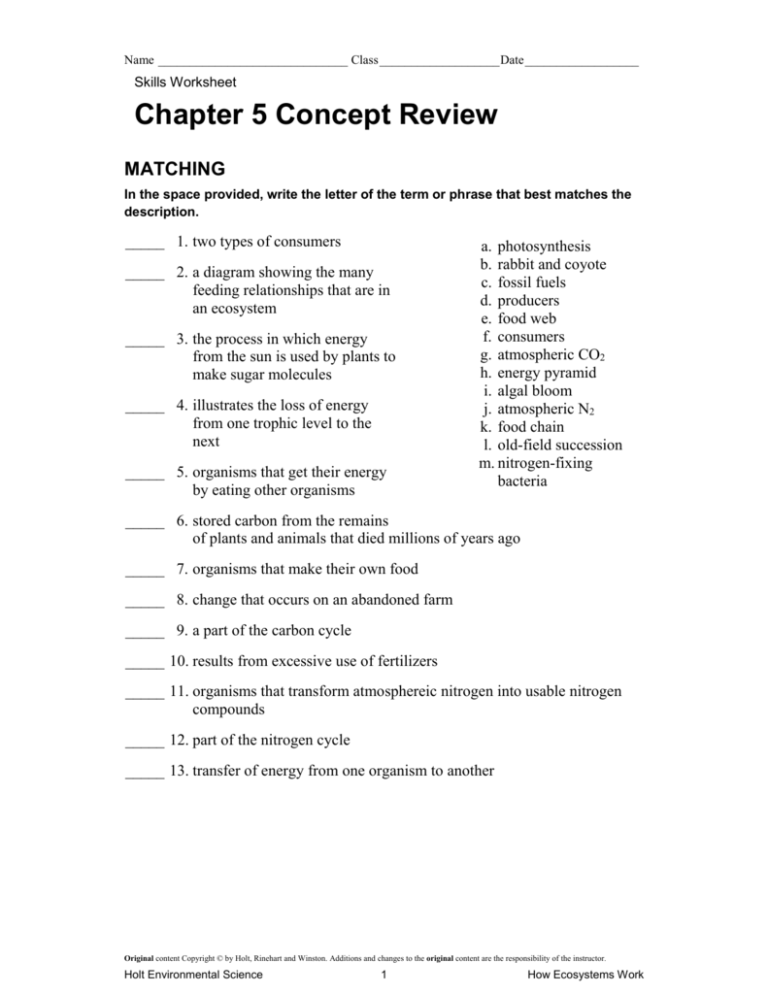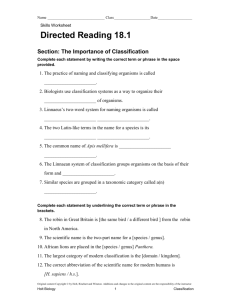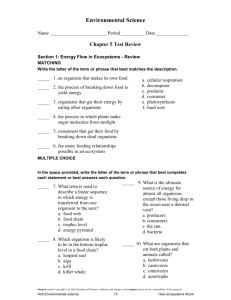Chapter 5 Concept Review
advertisement

Name ______________________________ Class ___________________ Date __________________ Skills Worksheet Chapter 5 Concept Review MATCHING In the space provided, write the letter of the term or phrase that best matches the description. _____ 1. two types of consumers _____ 2. a diagram showing the many feeding relationships that are in an ecosystem _____ 3. the process in which energy from the sun is used by plants to make sugar molecules _____ 4. illustrates the loss of energy from one trophic level to the next _____ 5. organisms that get their energy by eating other organisms a. photosynthesis b. rabbit and coyote c. fossil fuels d. producers e. food web f. consumers g. atmospheric CO2 h. energy pyramid i. algal bloom j. atmospheric N2 k. food chain l. old-field succession m. nitrogen-fixing bacteria _____ 6. stored carbon from the remains of plants and animals that died millions of years ago _____ 7. organisms that make their own food _____ 8. change that occurs on an abandoned farm _____ 9. a part of the carbon cycle _____ 10. results from excessive use of fertilizers _____ 11. organisms that transform atmosphereic nitrogen into usable nitrogen compounds _____ 12. part of the nitrogen cycle _____ 13. transfer of energy from one organism to another Original content Copyright © by Holt, Rinehart and Winston. Additions and changes to the original content are the responsibility of the instructor. Holt Environmental Science 1 How Ecosystems Work Name ______________________________ Class ___________________ Date __________________ MULTIPLE CHOICE d. sugar molecules _____ 14. What are the first organisms to colonize any newly avail-able area called? a. climax species b. Ferns c. pioneer species d. mosses _____ 19. Which of the following is an herbivore? a. cow b. lion c. bear d. grass _____ 20. Which of the following is a producer? a. oak tree b. raccoon c. cockroach d. human _____ 15. Which of the following is a producer that breaks down rock? a. pioneer producer b. fungal species c. algae d. lichen _____ 21. Which of the following is a process in the cell where by glucose and oxygen produce carbon dioxide, water, and energy? a. photosynthesis b. cellular respiration c. synthesis d. decomposition _____ 16. Humans are affecting the balance of the carbon cycle by a. burning fossil fuels. b. using carbonates at an alarming rate. c. using fertilizers. d. replanting the rainforests. _____ 22. Which of the following organisms would be found at the top of an energy pyramid? a. alga b. krill c. leopard seal d. killer whale _____ 17. What is a pattern of change that occurs on a surface where an ecosystem has previously existed? a. primary succession b. secondary succession c. tertiary succession d. climax community _____ 23. Humans usually get the phosphorus that their bodies need from a. eating plants and animals that contain phosphorus. b. mining. c. food additives. d. drinking water. _____ 18. What do deep-ocean bacteria use to make their food? a. the sun b. hydrogen sulfide c. carbon dioxide Original content Copyright © by Holt, Rinehart and Winston. Additions and changes to the original content are the responsibility of the instructor. Holt Environmental Science 2 How Ecosystems Work TEACHER.RESOURCE.PAGE Answer Key Concept Review MATCHING 1. 2. 3. 4. 5. 6. 7. b e a h f c d 8. 9. 10. 11. 12. 13. l g i m j k MULTIPLE CHOICE 14. 15. 16. 17. 18. c d a b b 19. 20. 21. 22. 23. a a b d a Critical Thinking ANALOGIES 1. b 2. d 3. b 4. c 5. b 6. d INTERPRETING OBSERVATIONS 7. Answers may vary. Sample answer:Native grasses are adapted to the soil and climatic conditions of the area.Replacing these grasses with nonna- tive grasses is contrary to the purpose of a nature preserve. Nonnative grasses may require maintenance to keep them thriving. Organisms that depend on the native grasses may die when their food source and habitat are removed from the area. 8. Answers may vary. Sample answer: Importing exotic animals that are not part of the natural habitat is also con-trary to the purpose of a nature pre-serve. Nonnative species may die because the available food sources and habitats are unsuitable. They will require additional care to survive. 9. Answers may vary. Sample answer: A play ground that can be easily accessed by vehicles on a paved road would be better suited to a park setting than an a ture preserve. The resulting traffic would not benefit a thriving nature preserve. This area should be more primitive. Hiking trails would be more appropriate than paved roads. AGREE OR DISAGREE 10. Accept any reasonable answer. Sample answers: Agree; the sun is the ultimate source of energy for all living things, even those that eat only meat.Disagree; life would continue in the deep sea, fueled by the bacteria that convert hydrogen sulfide to food.Eventually, new life-forms that depend on this new “ultimate” energy source may evolve. 11. Disagree; by burning fossil fuels, we release carbon into the atmosphere in the form of carbon dioxide. Due to the large amounts of fossil fuels that we are burning, the concentration of car-bon dioxide in the atmosphere has increased. This upsets the previous balance between the carbon under-ground, the carbon in organisms, and the carbon in the air (carbon dioxide). 12. Agree; a severe drought will reduce the amount of grass available for food for the primary consumers. Some of the primary consumers will starve to death.With fewer primary consumers to Original content Copyright © by Holt, Rinehart and Winston. Additions and changes to the original content are the responsibility of the instructor. Holt Environmental Science 85 How Ecosystems Work TEACHER.RESOURCE.PAGE ser veas their energy source, secondary con-sumers will also starve. Starvation will continue up the energy pyramid. REFINING CONCEPTS 13. Accept any reasonable answer. Sample answer: Primary succession is the regu- lar pattern of ecological changes that occur over time on a previously unoc-cupied surface. Secondary succession describes the ecological changes that occur on a previously occupied surface. The distinction between the two is sometimes confusing. Never-occupied surfaces, such as newly exposed bedrock (from a retreating glacier) qualify as “previously unoccupied” locations. Lichens living there would be re erred to as “primary succession.” Original content Copyright © by Holt, Rinehart and Winston. Additions and changes to the original content are the responsibility of the instructor. Holt Environmental Science 86 How Ecosystems Work








